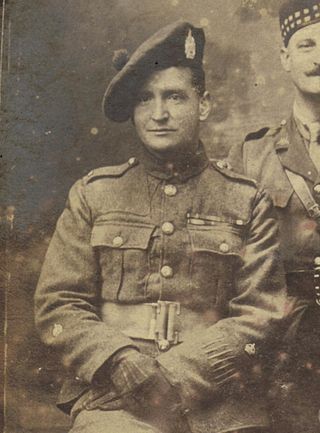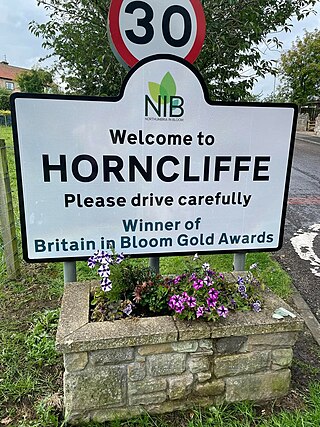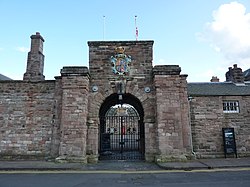
Northumberland is a ceremonial county in North East England, bordering Scotland. It is bordered by the Scottish Borders to the north, the North Sea to the east, Tyne and Wear and County Durham to the south, and Cumbria to the west. The town of Blyth is the largest settlement while Alnwick is the historic county town.

Berwick-upon-Tweed, sometimes known as Berwick-on-Tweed or simply Berwick, is a town and civil parish in Northumberland, England, 2+1⁄2 mi (4 km) south of the Anglo-Scottish border, and the northernmost town in England. The 2011 United Kingdom census recorded Berwick's population as 12,043.

The King's Own Scottish Borderers (KOSBs) was a line infantry regiment of the British Army, part of the Scottish Division. On 28 March 2006 the regiment was amalgamated with the Royal Scots, the Royal Highland Fusiliers, the Black Watch, the Highlanders, the Argyll and Sutherland Highlanders, 52nd Lowland Regiment, and 51st Highland Regiment to form the Royal Regiment of Scotland. However, after just a few months the battalion merged with the Royal Scots Battalion to form the Royal Scots Borderers.

John Kendrick Skinner VC, DCM was a Scottish recipient of the Victoria Cross, the highest and most prestigious award for gallantry in the face of the enemy that can be awarded to British and Commonwealth forces.

Gustavus Hamilton Blenkinsopp Coulson, was a British Army officer and an English recipient of the Victoria Cross, the highest decoration for gallantry "in the face of the enemy" awarded to members of the British and Commonwealth armed forces.

William Henry Grimbaldeston VC was an English recipient of the Victoria Cross, the highest and most prestigious award for gallantry in the face of the enemy that can be awarded to British and Commonwealth forces.

Berwick Bridge, also known as the Old Bridge, spans the River Tweed in Berwick-upon-Tweed, Northumberland, England. The current structure is a Grade I listed stone bridge built between 1611 and 1624.

Berwick-upon-Tweed is a railway station on the East Coast Main Line, which runs between London King's Cross and Edinburgh Waverley. The station, situated 67 miles (108 km) north-west of Newcastle, serves the border town of Berwick-upon-Tweed in Northumberland, England. It is owned by Network Rail and managed by London North Eastern Railway.

The Royal Northumberland Fusiliers was an infantry regiment of the British Army. Raised in 1674 as one of three 'English' units in the Dutch Anglo-Scots Brigade, it accompanied William III to England in the November 1688 Glorious Revolution and became part of the English establishment in 1689.
This timeline summarises significant events in the history of Northumbria and Northumberland.

Berwick Castle is a ruined castle in Berwick-upon-Tweed, Northumberland, England.

The Royal Regiment of Scotland (SCOTS) is the senior and only current Scottish line infantry regiment of the British Army Infantry. It consists of three regular and two reserve battalions, plus an incremental company, each formerly an individual regiment. However, three regular battalions maintain their former regimental pipes and drums to carry on the traditions of their antecedent regiments.
The Royal Scots Borderers, 1st Battalion, the Royal Regiment of Scotland was an infantry battalion of the Royal Regiment of Scotland. The battalion formed on 1 August 2006 when its antecedent regiments - the Royal Scots and the King's Own Scottish Borderers - amalgamated just after the formation of the Royal Regiment of Scotland in 2006. On 1 December 2021, the battalion transferred to the new Ranger Regiment as the 1st Battalion, Ranger Regiment.

The Anglo-Scottish border is a border separating Scotland and England which runs for 96 miles (154 km) between Marshall Meadows Bay on the east coast and the Solway Firth in the west.
In countries whose armies are organised on a regimental basis, such as the army of the United Kingdom, a regimental museum is a military museum dedicated to the history of a specific army regiment.

Horncliffe is a village in the county of Northumberland, England. It lies on the south bank of the River Tweed about 5 miles (8 km) south west of Berwick-upon-Tweed, and about 3 miles (5 km) north east of Norham and is the most northerly village in England.

Scremerston is a village in Northumberland, England. The village lies on the North Sea coast just under 2.5 miles (4 km) south of Berwick-upon-Tweed and 4.3 miles (7 km) from the Anglo-Scottish border. It is adjacent to the A1, providing access to Newcastle upon Tyne to the south, and to Edinburgh to the north.

The regimental depot of a regiment is its home base for recruiting and training. It is also where soldiers and officers awaiting discharge or postings are based and where injured soldiers return to full fitness after discharge from hospital before returning to full duty. Normally, a variety of regimental stores will also be kept at the depot. The regimental depot is not the same as the regimental headquarters, though in practice the two will often be co-located in the same place.
The Berwick Gymnasium Arts Fellowships were established in 1993 and were offered annually to professional artists who had demonstrated a consistent commitment to their art practice. The Fellowships were an internationally renowned programme open to all artists; national and international. Located in Berwick-upon-Tweed, England, the Fellowships were intended to give artists a period of time when they could reflect upon their practice and focus on the development of their work, responding to the border town of Berwick-upon-Tweed and its coastal location. The former military barracks, known as Berwick Barracks, that housed the studios and gallery space used by artists were built in the early 18th century to the design of the architect Nicholas Hawksmoor. The barracks were among the first in England to be purpose built. The fellowships were jointly funded by English Heritage and Arts Council England until 2011. The fellowships came to an end in 2011 after English Heritage announced funding cuts.

Philip Babington (1632–1690) was an English military officer, who served in the armies of the Commonwealth of England, the Dutch Republic and England. He accompanied William III to England in the 1688 Glorious Revolution and was Member of Parliament and Governor for Berwick-upon-Tweed from 1689 to 1690.
















